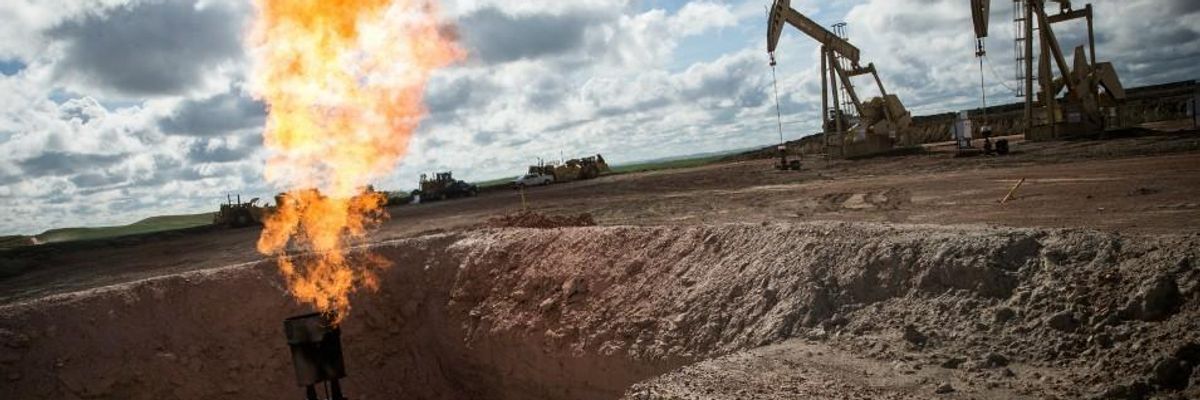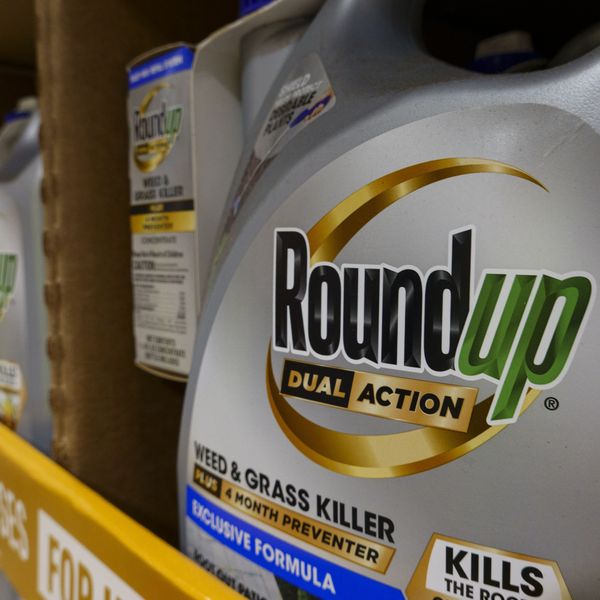
A gas flare is seen at an oil well site on outside Williston, North Dakota. (Photo: Andrew Burton/Getty Images)
Bolstering Public Health Fears, Harvard Study Finds Elevated Airborne Radiation Levels Downwind of US Fracking Sites
"If you asked me to go and live downwind [of fracking sites], I would not go," said the lead author of the new study.
A study released Tuesday by a team of scientists from Harvard University found that airborne radiation levels downwind of U.S. fracking sites are significantly elevated compared to background levels, providing further evidence that the drilling practice poses a threat to public health as well as the climate.
Published in the journal Nature Communications, the study detected the largest increases in airborne radiation levels near drilling locations in Pennsylvania and Ohio, states with high concentrations of fracking sites.
"Our results suggest that an increase in [particle radioactivity] due to the extensive [fracking development] may cause adverse health outcomes in nearby communities," warned the study, which found that locations within 12 miles downwind of 100 fracking sites have around 7% higher radiation levels compared to background levels.
The impact of fracking on airborne particle radioactivity "decreases gradually along with an increasing downwind distance" from oil and gas wells, the researchers noted.
Petros Koutrakis, the lead author of the study, told The Guardian that "if you asked me to go and live downwind [of fracking sites], I would not go. People should not go crazy, but I think it's a significant risk that needs to be addressed."
\u201cNEW HARVARD STUDY: \n\nUS #fracking wells bring radioactive particles up from the shattered shale bedrock and spew them into the air. \n\nResearchers found increases in downwind radioactivity 12 miles away from wells.\n\n#Fracking = Pandora\u2019s box of horrors https://t.co/Rwo6pSmtIy\u201d— Dr. Sandra Steingraber (@Dr. Sandra Steingraber) 1602679373
The new study comes as fracking continues to figure prominently in the 2020 presidential race, with President Donald Trump openly celebrating the destructive practice and Democratic nominee Joe Biden vowing not to completely ban it if elected--a stance that has drawn the ire of environmental activists and progressive lawmakers.
"Fracking is bad, actually," Rep. Alexandria Ocasio-Cortez (D-N.Y.) tweeted after Sen. Kamala Harris (D-Calif.), Biden's running mate, said during last week's vice presidential debate that a Biden administration "will not ban fracking."
An Urgent Message From Our Co-Founder
Dear Common Dreams reader, The U.S. is on a fast track to authoritarianism like nothing I've ever seen. Meanwhile, corporate news outlets are utterly capitulating to Trump, twisting their coverage to avoid drawing his ire while lining up to stuff cash in his pockets. That's why I believe that Common Dreams is doing the best and most consequential reporting that we've ever done. Our small but mighty team is a progressive reporting powerhouse, covering the news every day that the corporate media never will. Our mission has always been simple: To inform. To inspire. And to ignite change for the common good. Now here's the key piece that I want all our readers to understand: None of this would be possible without your financial support. That's not just some fundraising cliche. It's the absolute and literal truth. We don't accept corporate advertising and never will. We don't have a paywall because we don't think people should be blocked from critical news based on their ability to pay. Everything we do is funded by the donations of readers like you. Will you donate now to help power the nonprofit, independent reporting of Common Dreams? Thank you for being a vital member of our community. Together, we can keep independent journalism alive when it’s needed most. - Craig Brown, Co-founder |
A study released Tuesday by a team of scientists from Harvard University found that airborne radiation levels downwind of U.S. fracking sites are significantly elevated compared to background levels, providing further evidence that the drilling practice poses a threat to public health as well as the climate.
Published in the journal Nature Communications, the study detected the largest increases in airborne radiation levels near drilling locations in Pennsylvania and Ohio, states with high concentrations of fracking sites.
"Our results suggest that an increase in [particle radioactivity] due to the extensive [fracking development] may cause adverse health outcomes in nearby communities," warned the study, which found that locations within 12 miles downwind of 100 fracking sites have around 7% higher radiation levels compared to background levels.
The impact of fracking on airborne particle radioactivity "decreases gradually along with an increasing downwind distance" from oil and gas wells, the researchers noted.
Petros Koutrakis, the lead author of the study, told The Guardian that "if you asked me to go and live downwind [of fracking sites], I would not go. People should not go crazy, but I think it's a significant risk that needs to be addressed."
\u201cNEW HARVARD STUDY: \n\nUS #fracking wells bring radioactive particles up from the shattered shale bedrock and spew them into the air. \n\nResearchers found increases in downwind radioactivity 12 miles away from wells.\n\n#Fracking = Pandora\u2019s box of horrors https://t.co/Rwo6pSmtIy\u201d— Dr. Sandra Steingraber (@Dr. Sandra Steingraber) 1602679373
The new study comes as fracking continues to figure prominently in the 2020 presidential race, with President Donald Trump openly celebrating the destructive practice and Democratic nominee Joe Biden vowing not to completely ban it if elected--a stance that has drawn the ire of environmental activists and progressive lawmakers.
"Fracking is bad, actually," Rep. Alexandria Ocasio-Cortez (D-N.Y.) tweeted after Sen. Kamala Harris (D-Calif.), Biden's running mate, said during last week's vice presidential debate that a Biden administration "will not ban fracking."
A study released Tuesday by a team of scientists from Harvard University found that airborne radiation levels downwind of U.S. fracking sites are significantly elevated compared to background levels, providing further evidence that the drilling practice poses a threat to public health as well as the climate.
Published in the journal Nature Communications, the study detected the largest increases in airborne radiation levels near drilling locations in Pennsylvania and Ohio, states with high concentrations of fracking sites.
"Our results suggest that an increase in [particle radioactivity] due to the extensive [fracking development] may cause adverse health outcomes in nearby communities," warned the study, which found that locations within 12 miles downwind of 100 fracking sites have around 7% higher radiation levels compared to background levels.
The impact of fracking on airborne particle radioactivity "decreases gradually along with an increasing downwind distance" from oil and gas wells, the researchers noted.
Petros Koutrakis, the lead author of the study, told The Guardian that "if you asked me to go and live downwind [of fracking sites], I would not go. People should not go crazy, but I think it's a significant risk that needs to be addressed."
\u201cNEW HARVARD STUDY: \n\nUS #fracking wells bring radioactive particles up from the shattered shale bedrock and spew them into the air. \n\nResearchers found increases in downwind radioactivity 12 miles away from wells.\n\n#Fracking = Pandora\u2019s box of horrors https://t.co/Rwo6pSmtIy\u201d— Dr. Sandra Steingraber (@Dr. Sandra Steingraber) 1602679373
The new study comes as fracking continues to figure prominently in the 2020 presidential race, with President Donald Trump openly celebrating the destructive practice and Democratic nominee Joe Biden vowing not to completely ban it if elected--a stance that has drawn the ire of environmental activists and progressive lawmakers.
"Fracking is bad, actually," Rep. Alexandria Ocasio-Cortez (D-N.Y.) tweeted after Sen. Kamala Harris (D-Calif.), Biden's running mate, said during last week's vice presidential debate that a Biden administration "will not ban fracking."

